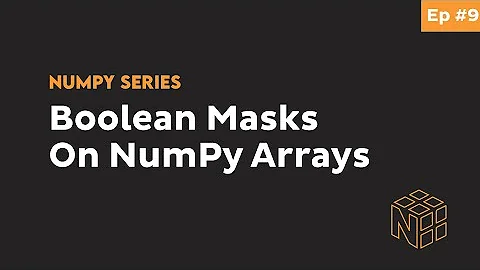Why do "Not a Number" values equal True when cast as boolean in Python/Numpy?
Solution 1
This is in no way NumPy-specific, but is consistent with how Python treats NaNs:
In [1]: bool(float('nan'))
Out[1]: True
The rules are spelled out in the documentation.
I think it could be reasonably argued that the truth value of NaN should be False. However, this is not how the language works right now.
Solution 2
Python truth-value testing states that the following values are considered False:
- zero of any numeric type, for example, 0, 0L, 0.0, 0j.
Numpy probably chose to stick with this behaviour and prevent NaN from evaluating to False in a boolean context. Note however that you can use numpy.isnan to test for NaN.
Solution 3
0.0 is the only falsy float value because that's what the language designers decided would be most useful. Numpy simply follows along. (It would be weird to have bool(np.nan) be False when bool(float('nan')) is True).
I think it is probably because that's how things work with integers. Admittedly, integers have no NaN or inf types of values, but I suppose that special cases aren't special enough to break the rules.
Solution 4
Numpy follows the python standard for truth testing here, any numeric type evaluates to False if and only if its numerical value is zero.
Note that truth testing with NaN values can be unintuitive in other ways as well (e.g., nan == nan evaluates to False).
Related videos on Youtube
rroowwllaanndd
Updated on September 15, 2022Comments
-
 rroowwllaanndd almost 2 years
rroowwllaanndd almost 2 yearsWhen casting a NumPy Not-a-Number value as a boolean, it becomes True, e.g. as follows.
>>> import numpy as np >>> bool(np.nan) TrueThis is the exact opposite to what I would intuitively expect. Is there a sound principle underlying this behaviour?
(I suspect there might be as the same behaviour seems to occur in Octave.)
-
Fred Foo about 11 yearsMy hunch: NaN is not equal to zero, so it's true when converted to boolean. If NaN were false, then conversion of floats to booleans would take two checks, one for zero and one for NaN. (But I suspect interpreting Numpy floats as booleans is not common practice anyway...)
-
jerry about 11 yearsThis is also the case in C (on which NumPy is based). From the standard:
When any scalar value is converted to _Bool, the result is 0 if the value compares equal to 0; otherwise, the result is 1.Footnote 59 explicitly states thatNaNs do not compare equal to 0 and thus convert to 1.
-
-
Fred Foo about 11 yearsIt's not up to the language designers; the Numpy folks could have decided to make
nanfalse as well. -
 mgilson about 11 years@larsmans -- Fair enough. I didn't notice that
mgilson about 11 years@larsmans -- Fair enough. I didn't notice thatnumpywas part of the OP's question. I don't think that really changes anything though. It just makes sense fornumpyto do what python does. -
Warren Weckesser about 11 yearsI think you meant "... evaluates to
Falseif ..." -
Kelsey about 11 years@Warren -- indeed! Thanks.
-
Jostikas over 7 yearsShould note that -0.0 is also False. It's a thing that may at first not be trivial.
-
 Kardo Paska almost 4 yearsTL;DR for linked docs: Python treats everything as
Kardo Paska almost 4 yearsTL;DR for linked docs: Python treats everything asTrueunless it is one of the specifically defined false cases (e.g.,None,False, numeric zeroes, empty sequences, user-defined classes that return one of these, etc.). -
Michael Tuchman almost 4 yearsI think it should be NaN in all types. That is, boolean should have a NaN value. NaN should never cast to a valid value.





![[Pandas Tutorial] how to check NaN and replace it (fillna)](https://i.ytimg.com/vi/JJaLtI-6BT0/hqdefault.jpg?sqp=-oaymwEcCOADEI4CSFXyq4qpAw4IARUAAIhCGAFwAcABBg==&rs=AOn4CLCBSYaunluvyPFx6OZQJiLiBLuOmg)







